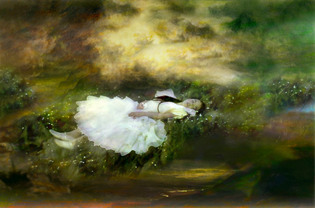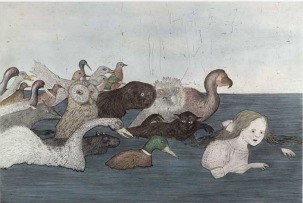It’s sometimes a little dangerous to compliment an exhibition from afar, but I’m going to do it anyway with a show that opened earlier this month at the Tate Liverpool — for two reasons.
 One, I love the concept: Alice in Wonderland is, the museum says, “the first exhibition of its kind to explore how Lewis Carroll’s stories have influenced the visual arts, inspiring generations of artists.” It seems a no-brainer, doesn’t it?
One, I love the concept: Alice in Wonderland is, the museum says, “the first exhibition of its kind to explore how Lewis Carroll’s stories have influenced the visual arts, inspiring generations of artists.” It seems a no-brainer, doesn’t it?
And speaking of brains, that’s the second reason for highlighting this exhibition, more about which in a minute.
 The exhibition goes to the source: Carroll’s original 1864 manuscript, which he wrote and illustrated as a gift for ten-year-old Alice Liddell; it’s on loan from the British Library. The images were, as the Tate says, “central to the story, creating a visual world which took on a life of its own.” Carroll’s drawings and photographs, as well as Victorian Alice memorabilia (biscuit tins, tea tins, figurines, etc.) and John Tenniel’s preliminary drawings for the first edition of the novel, are on view.
The exhibition goes to the source: Carroll’s original 1864 manuscript, which he wrote and illustrated as a gift for ten-year-old Alice Liddell; it’s on loan from the British Library. The images were, as the Tate says, “central to the story, creating a visual world which took on a life of its own.” Carroll’s drawings and photographs, as well as Victorian Alice memorabilia (biscuit tins, tea tins, figurines, etc.) and John Tenniel’s preliminary drawings for the first edition of the novel, are on view.
Next comes the art Alice inspired, works by Salvador DalÃ, René Magritte, Peter Blake, Yayoi Kusama, Anna Gaskell, Kiki Smith (her Pool of Tears 2, left), Annelies Strba (her Nyima 438 above, right) and Torsten Lauschmann. (Five of them, the Tate says, are “not suitable for children,” alas.)
The Tate has provided an 18-page educator’s pack, but that’s not all. It has also posted online “Wondermind,” a set of games and videos that “explore the science of your brain” — for kids aged 8 to 12. I played along and watched a few of the videos and they are fantastic. They neither talk above kids’ heads nor dumb things down. Here’s a blog post that explains some of what’s on offer. There are play stations in the Tate but everything is also accessible from any computer.
Endorsing Wondermind without going through it all is a little like reviewing a book without reading the whole thing — so let me just admit this upfront: I have not played all of what’s there. But if the start is a guide, I’m pretty confident you and your kids, or grandkids, will like it and learn from it. Here’s a press release I discovered after I played some games. It says, among other things, “this project is the first time that Tate has engaged scientists to work directly with children” and adds:
Players need to complete tasks such as finding out who painted the Queen of Hearts’ roses, helping Alice find the Cheshire Cat and White Rabbit, and making sure the Mad Hatter delivers a specific type of tea into the cups of his guests. Through the games, players will learn about the development of cognitive functions such as memory, spatial awareness and language.
Bravo to the Tate Liverpool.
Photo Credits: Courtesy of the artists
